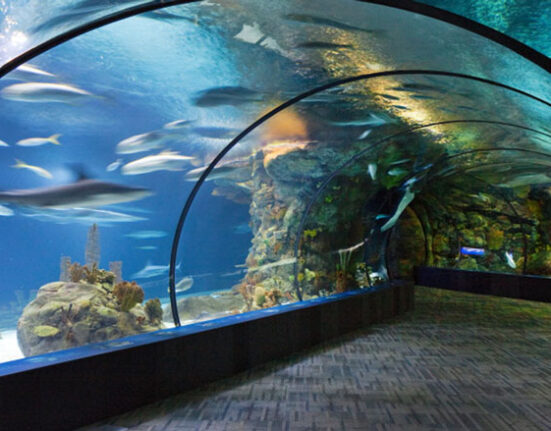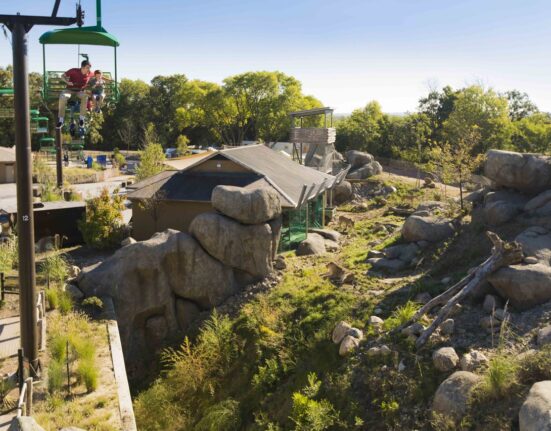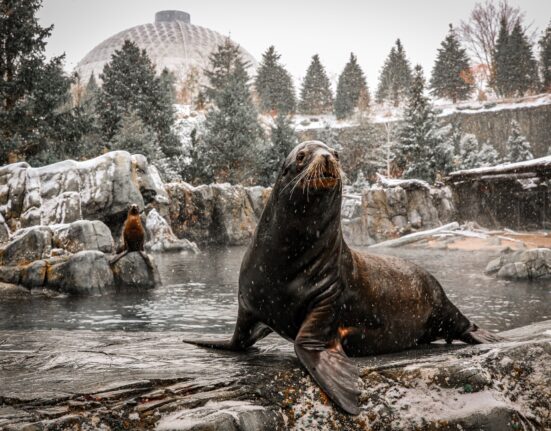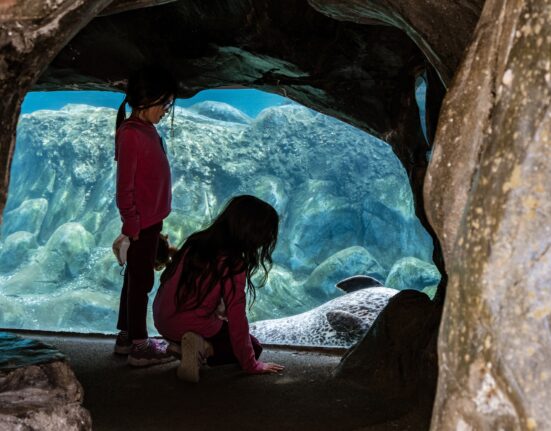Exciting things were happening at Omaha’s Henry Doorly Zoo and Aquarium in 2018, including the first phase of Asian Highlands, animal births and conservation milestones. Below is a recap of some of the big events that happened at Omaha’s Zoo and Aquarium the past year:
10 – Omaha Zoo Railroad Celebrates 50th Anniversary
In July, the Omaha Zoo Railroad celebrated its 50th anniversary. The Railroad’s official Golden Spike dedication ceremony took place on July 23, 1968. Mayor A.V. Sorenson and Edd H. Bailey, Union Pacific’s president at the time, drove the brass-plated “golden spike” at the ceremony that officially marked the completion of the Omaha Zoo Railroad. The Zoo celebrated with a trivia-based social media contest for one lucky winner to “become an engineer” for a morning. Zoo visitors also received free railroad-themed temporary tattoos.
9 – Olmec Installation
“The King,” a replica of Olmec Colossal Head No. 1, from Omaha’s sister city Xalapa, Mexico, was installed in the Lied Jungle® at Omaha’s Zoo and Aquarium in February and was formally dedicated in May.
The statue is a 25,000-pound gift to the city of Omaha. According to Dr. Hipólito Rodríguez Herrero, Mayor of Xalapa, Veracruz, Mexico, the statue is a symbol of the immense gratitude, appreciation and affection the city of Xalapa has for Omaha. The statue was sculpted by Ignacio Perez Solano under the authority of the National Institute of Anthropology and History in Xalapa.
8 – Zoo Brew Series
Omaha’s Henry Doorly Zoo and Aquarium and Zipline Brewing Co. have partnered to bring you the Zoo Brew Series – four limited edition beers with a focus on the conservation efforts of four different animal species: red panda, African elephant, rockhopper penguin and snow leopard. Proceeds from the Zoo Brew Series, which began launching in July and will continue into 2019, directly support field conservation projects around the globe.
In 2018, Red Panda Wheat and African Elephant XPA were sold at the Zoo, Zipline Brewing Co. and select retail outlets. Red Panda Wheat was brewed with red wheat and bamboo shoots (a favorite food of red pandas). African Elephant XPA, an extra pale ale, was brewed and dry-hopped exclusively with Southern Star hops from South Africa. The remaining two beers in the series will launch in 2019.
7 – Wildlife Safari Park Celebrates 20th Anniversary with USA TODAY 10Best Win
In June 2018, Wildlife Safari Park celebrated its 20th anniversary with special activities for visitors including cowboy visits, a children’s bounce house and behind-the-scenes tours of Wildlife Safari Park’s hospital and Cheetah Breeding Center.
Wildlife Safari Park was also named “Best Safari Park” in America by USA TODAY 10Best Readers’ Choice Travel Awards. The 10Best Readers’ Choice Travel Awards are selected through public voting. The winners were announced on the 10Best website and on USA TODAY.
10Best, which provides travel advice to more than 40 million travelers annually, asks its readers to choose the 10Best in a single category each week. These categories range from food, lodging and destinations to travel
gear and things to do. 10Best’s travel experts select the top 20 nominees for each category and have the readers vote to determine the top 10 selections.
Wildlife Safari Park offers four miles of drive-through North American wildlife viewing from the comfort of your own vehicle. Wildlife Safari Park visitors will see a variety of animals in their natural habitats, including more than 60 American elk spread across the 50-acre Elk Meadow and a 10-acre wetlands area with American white pelicans. Visitors can explore the newest exhibit, Prairie Dog Town, and see other animals, such as deer, Sandhill cranes, trumpeter swans and bison, the largest terrestrial and heaviest land animals in North America.
Mid-way through Wildlife Safari Park, visitors can take advantage of nice weather and explore on foot. Two miles of hiking trails pass Wolf Canyon, which features six grey wolves and three American black bears. The Hands-on-Corral allows kids of all ages the chance to interact with their favorite farm animals, such as pygmy goats and chickens.
6 – Attendance Milestones
The Zoo hit major attendance milestones when it welcomed its 25 millionth member in April and its 50 millionth visitor through its gates in September.
In 1966, just less than 88 thousand people visited Omaha’s Zoo. Attendance more than doubled the following year to 229 thousand following the opening of the Bear Grottos, Ape Buildings and Nature Kingdom. The Zoo reached a milestone of one million visitors for its first time in 1992, the same year the Lied Jungle opened. Attendance steadily grew throughout the next fourteen years until the Zoo would reach a new milestone of two million visitors in 2016 with the opening of its largest project to date, African Grasslands. Today, Omaha’s Henry Doorly Zoo and Aquarium sees around two million guests through its gates each year.
Along with attendance, the amount of Zoo membership holders has grown substantially throughout its history. In 1972, the Zoo had 900 memberships. Today, that number has grown to more than 89,000. In 2017, almost 59 percent of Omaha’s Henry Doorly Zoo and Aquarium visitors were Zoo members, compared to only 4 percent in 1972.
5 – The Zoo Takes Big Steps in Reducing Single-Use Plastics
In 2018, Omaha’s Henry Doorly Zoo and Aquarium joined twenty-one top aquariums across the United States to eliminate five million straws in their coordinated campaign to reduce sources of plastic pollution. This year, the Zoo also eliminated its use of Styrofoam in its eateries.
In 2018 the group went further to encourage people, businesses and cities across the nation to reduce single-use plastic, especially plastic straws by Earth Day 2019. Now with #FirstStep to plastic-free waters we can all get involved. The #FirstStep campaign includes:
• Recruiting 500 new businesses to partner with aquariums across the country by committing to offer straws only on request by Earth Day 2019
• An online pledge site (pledge.ourhands.org) where individuals can commit to make the last straw their first step to plastic-free waters
• Initiatives by partner aquariums to inspire cities in their regions to pass straws-on-request ordinances and other local measures to reduce single-use plastic
• An opportunity for individuals to get tips via text message on ways to cut back on single-use plastic in their daily lives, by texting “TURTLE” to 49767
For more information about the #FirstStep campaign or to take the pledge, please visit pledge.ourhands.org/.
4 – Two Million Trees Planted in Madagascar
Omaha’s Henry Doorly Zoo and Aquarium, in partnership with Madagascar Biodiversity Partnership (MBP), planted its two millionth tree in Madagascar in August. Since 2012, the organizations’ reforestation efforts have been focused on providing habitat for lemurs, the most threatened group of mammals in the world.
Nearly all species of lemurs, which only live on the African island of Madagascar, are threatened due to habitat loss caused by deforestation. In 2012, the Zoo and MBP set a five-year goal to plant one million trees, which was reached in 2017. Fueled by the support of the Arbor Day Foundation, Omaha’s Henry Doorly Zoo and Aquarium and MBP were able to plant an additional one million trees in less than two years.
The Zoo’s work in Madagascar is being led by Dr. Edward E. Louis Jr., director of the conservation genetics department at Omaha’s Henry Doorly Zoo and Aquarium and founder of MBP. From the project’s beginning, Dr. Louis has aimed to balance the welfare of the Malagasy people with protecting the nation’s biodiversity. Commercial trees, such as bamboo, banana and cinnamon are a vital part of the reforestation program as they provide community members additional income. Each tree grown for the project begins as a seedling and is nurtured to maturity within a nursery by Zoo staff, MBP and the local community.
3 – Endangered Species Animal Births
Omaha’s Henry Doorly Zoo and Aquarium had some exciting animal births this year. Animals born in 2019 include:
• On April 30, the Zoo welcomed a male pygmy hippopotamus calf. He is the first pygmy hippo calf that has been in a habitat in the Lied Jungle® since 2015, and only the fourth since the exhibit opened in 1992. The species is listed as Endangered on the International Union for Conservation of Nature’s (IUCN) Red List of Threatened Species with less than 2,500 remaining in the wild.
• Two Red ruffed lemurs, a critically endangered species, were born on May 8. These were the first Red ruffed lemurs to be born at the Zoo since 1996. Red ruffed lemurs are currently listed as Critically Endangered by the IUCN Red List. Lemurs, which live on the island of Madagascar, face threats such as loss of habitat and hunting.
• A female Malayan tapir calf was born at the Zoo on August 31. Malayan tapirs are listed as Endangered on the IUCN Red List of Threatened Species. Omaha’s Henry Doorly Zoo and Aquarium has been part of the Malayan tapir Species Survival Plan (SSP) since 1992 when the Lied Jungle® first opened.
2 – Asian Highlands Phase 1
The first phase of Asian Highlands opened in May of 2018. Asian Highlands transports Zoo guests on an immersive journey through Asia, ranging from the grasslands of Northern India, through the Himalayan Mountains. In Phase I of Asian Highlands, guests encounter a unique landscape and diverse group of animals including red pandas, white-naped cranes, Indian rhinos, tufted deer and Pere David’s deer. These species are well adapted to live in cold environments and are available for viewing year-round.
The journey takes guests along the southern foothills of the Himalayan Range where an abandoned hillside settlement has been overtaken by nature. Stone wall structures sit among temperate forests with firs, deciduous hardwoods, rhododendrons and bamboo dotting the landscape. As with all animal habitats, and tied to the Zoo’s mission to provide the highest level of animal care, various landscape elements such as rocks, trees, felled logs, water bodies, terrain, wallows and natural substrates are included in each area to simulate natural habitats and promote species-appropriate animal behavior and activity.
Expected completion of Asian Highlands Phase II, which includes habitats for the sloth bears, tigers, snow leopards, takin and Chinese goral as well as the Yeti Camp (with restrooms and food service) and Kid’s Discovery Trail areas, is spring 2019.
1 – Groves’ Dwarf Lemur Discovery
A new species of lemur has been discovered in southeast Madagascar by a team of scientists at Omaha’s Henry Doorly Zoo and Aquarium in collaboration with scientists at Suny Polytechnic Institute and Global Wildlife Conservation.
The Groves’ Dwarf lemur, known to scientists as Cheirogaleus grovesi, is the 24th lemur to be discovered since 2006 by the Zoo’s Conservation Genetics Department led by Dr. Edward Louis Jr., in collaboration with its Malagasy partner, the Madagascar Biodiversity Partnership. Scientists were able to confirm this lemur as a distinct new species after analyzing its DNA. The Groves’ Dwarf lemur can be found in the forests of southeast Madagascar between Ranomafana World Heritage Site and National Park and Andringitra National Park. The reddish-brown nocturnal primate is smaller than a typical Nebraskan squirrel.






Leave feedback about this